Hiring is tough, and with the rise of remote work, it’s getting even tougher to find a diamond in a sea of global applicants.
When the whole world is your talent pool, it’s not uncommon to get thousands of applications per job opening. And if you’re looking to fill a large number of positions in a fairly short time period, known as high-volume hiring, it can be a lot to handle.
How do you screen a high volume of candidates quickly and effectively without sacrificing the quality of hire or the candidate experience? The answer is rather simple — with the right technology, of course!
However, as with high-volume hiring, finding the right software among the sea of options can be tough and time-consuming. So, we’ve dug into some of the latest software options and innovative strategies that will help you solve the most common challenges of high-volume hiring.
TL;DR — Key Takeaways
High-volume recruitment involves filling many open positions in a short time. It can also refer to the number of candidates who applied to one specific role (hint: a lot).
High-volume recruiting has its challenges, which can be exacerbated by inefficient processes, tight time constraints, a poor candidate experience, or a lengthy application process.
You can lean on automation and technology to combat these roadblocks. Leverage tools to automate repetitive busywork, get data-driven insights on where the hiring process can improve, and use skills tests to increase efficiency without sacrificing quality.
Out of a variety of great high-volume hiring tools, we think Toggl Hire is the best all-in-one solution that’s also free to start using (we’ll explain why in just a bit).
What is high-volume hiring?
High-volume hiring occurs when a company needs to fill a large number of openings within a given time frame. Whether you’re a hiring manager in a giant such as Amazon or Google, opening a new department or office location, or a start-up that’s quickly ramping up, hiring so many people at once can seem impossible without some software to help automate the process.
On the other hand, there are companies that don’t have many openings but still receive large numbers of applications at once. While we can’t compare ourselves to Google, we can say that we had quite a challenge at Toggl — the average opening attracts more than 1,500 applicants. Having fit-for-purpose, high-volume hiring software can significantly boost your recruitment capacity and de-stress your team.
In a nutshell, high-volume hiring is just like regular recruiting, but with many times the people and workload. Let’s explore some of the key challenges to overcome.
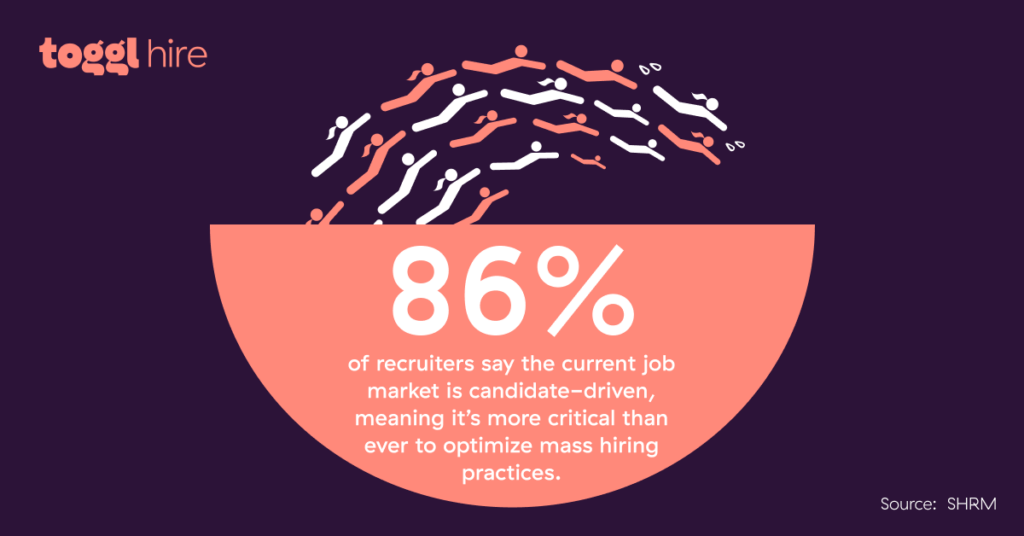
What are the most common challenges of the high-volume hiring process?
Many businesses need to hire a high volume of candidates to meet their staffing needs. While that might sound like a great problem to have (who doesn’t love growth, right?), it comes with its own set of challenges, which can hinder a company’s ability to attract, engage, and retain the best candidates.
Identifying and understanding these common challenges is the first step towards finding effective solutions for them. So, let’s take a closer look.
Lack of time
Hiring managers normally operate under tight time constraints. This leads to rushed decision-making, sub-optimal processes, and many inefficiencies.
There are two main reasons for this issue:
Not enough time: There simply aren’t enough hours in the day to review all the applications for a position (the average remote job posting receives over a thousand applications!).
Too many roles: You’re trying to fill multiple positions simultaneously and quickly, which can lead to errors or poor hiring decisions just to fill one position.
We get it, though. Hiring managers are under a lot of pressure to identify suitable candidates as soon as possible since the best talent is usually off the market in just ten days. However, it can really strain the hiring team and make screening for qualified candidates difficult.
Application method
Your recruiting processes should be as simple as possible. Job boards should clearly indicate open positions, and job postings need to be crystal clear to attract the most relevant talent. As with anything scalable, an automated screening process will give you a competitive edge and save time.
Remember to make the job application process user-friendly and accessible across various devices. A clunky initial experience with your brand might deter the right talent.
Technology should be your best friend here. Use the best recruitment tool for your budget to breeze through high-volume hiring without missing out on high-quality candidates.
Poor candidate experience
It’s important to have a well-considered, high-volume recruitment strategy to avoid many of the common pitfalls that could lead to a poor candidate experience.
Why is this so important? Because candidate experience can make or break your employer brand.
72% of candidates with a poor candidate experience will share this with their network, which could impact engagement and the number of applicants. On the flip side, 65% of rejected candidates who had a good experience are likely to apply again.
If you get it right, candidate experience can be a huge asset to your organization and reputation. Examples of things that lead to a positive candidate experience are maintaining clear communication, setting realistic expectations, and providing feedback to enhance the candidate’s journey.
Poor hire quality
Maintaining hiring quality is difficult. Especially when you have to screen hundreds or thousands of applicants, it’s natural to anticipate a range in the caliber of candidates. At the same time, it’s important to ensure that not a single qualified candidate slips through the cracks of your high-volume talent acquisition process.
In the long term, a recruiting process that isn’t designed to handle a large talent pipeline will cost you a lot — and we don’t just mean financially. You’ll be depleted of decision-making energy, facing increased turnover, training expenses, and HR and admin tasks related to hiring and onboarding new employees.
A great way around this issue is automation with online assessments. Skills tests are one of the easiest ways to identify patterns and find the right candidates among a large number of applicants.
If you haven’t already, try leveraging advanced screening technologies like Toggl Hire to improve your decision-making and quality of hires without extending the hiring timeline.

5 great high-volume recruiting strategies
Adapting to today’s dynamic hiring landscape requires innovative approaches and the smart use of technology. With the right high-volume recruiting strategy, you can easily avoid some of the most common high-volume hiring issues.
These five strategies and tips will help you streamline the recruitment process and enhance the quality of hires, even when dealing with high-volume recruiting.
1. Use data to optimize hiring processes
By analyzing key metrics from past hiring cycles, you can glean valuable insights into bottlenecks, successful sourcing channels, candidate behavior, and areas for improvement.
Your hiring teams can then implement those findings to inform things such as:
Job advertising: Which social recruiting tools or social media platforms drove the highest quality job seekers?
Screening criteria: Did you really need to screen for all the soft skills you were looking for? What do all the top new hires have in common? Maybe those are what you should focus on next.
Time of year to hire: Are certain times of year more fruitful than others to hire candidates? How can you capitalize on them to maximize your hiring efficiency across the year?
The type of insights you get will inform the areas you improve on, but these three examples give you an idea of the kind of questions you can ask once you have the data.
2. Automate processes and tasks
Repetitive manual work has got to go. In 2024, we’re only focusing on high-impact activities and automating tasks that no longer require manual effort. There are so many smart tools out there — everything from tools to sort resumes to scheduling interviews and maintaining communication with your candidate database.
Automation not only speeds up but also helps eliminate human error, allowing you and your team to focus on the more creative and strategic parts of talent acquisition.
3. Reengage with past applicants
If you aren’t using talent pools, start yesterday.
They’re like a hiring shortcut because, with them, you’re never starting from zero. Your candidate database is almost certainly already full of high-potential candidates your recruitment team can tap into to kickstart the hiring process.
Some important things to remember when re-engaging past candidates via talent pools:
Craft personalized re-engagement messages: You can use semi-templated messages to send mass communications with a personal touch. People love to feel remembered and your message will stand out against other stale recruitment pitches.
Keep in touch with the “runner-up”: Sometimes, candidates who are a great fit just miss out on job offers to another candidate. It’s important to keep in touch with this “runner-up” talent, as new roles might arise that are the perfect opportunity for them.
Many applicants will be passive candidates: These are candidates who aren’t actively looking for a new role but aren’t averse to taking an interview if it comes their way. Most of the best talent out there comes through like this, so it’s worth taking the time to be eye-catching and creative in your passive talent strategy.
Employer branding plays an important role in attracting both active and passive candidates. Today’s job seekers are looking for more than just a paycheck, scrutinizing your culture, benefits, and a sense of belonging.
4. Invest heavily in the candidate experience
A positive candidate experience is crucial in high-volume recruiting. It affects both your brand reputation and your ability to attract top talent.
Some top tips on how to shine:
Fast communication is key. The average time from application to job offer is 1-3 months, and it can be even longer the more senior the role. Automation can significantly reduce this time frame.
Be transparent: Candidates appreciate visibility into the whole hiring process right from the start. Manage expectations by clearly outlining the process on your website or in the job descriptions you share. Here at Toggl Hire, we’re firm believers in sharing the salary upfront, too!
Manage expectations: Tell candidates when they can expect to hear back from you—and then stick to that timeline. If you don’t value a candidate’s time during the recruitment process, you’re essentially telling them you don’t value their time as employees.
5. Use skills tests as the first step
When faced with thousands of job applications, what’s the fastest way to get to the top ten candidates? With a skills test.
Using a skills assessment early in the selection process allows you to cut through the noise and go straight to reviewing the cream of the crop. Narrow down the applicant pool to those who have the required skills, and spend your interviews talking about more interesting points like strategy and culture fit.
This gives you much better insight into a candidate’s personality, thinking, and potential fit into the company culture. It also saves you time and resources in the later stages of the high-volume recruiting process.
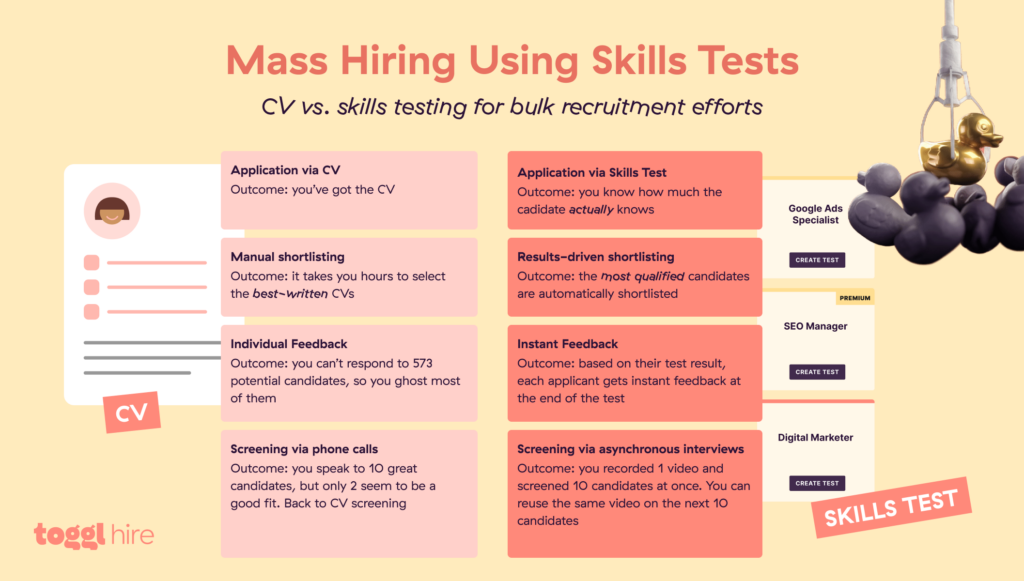
The best high-volume hiring software
High-volume hiring requires extensive automation and organization. Typically, the only way to ensure precision and efficiency in the process is through hiring software.
We’ve compiled a list of the five best hiring software for high-volume hiring and highlighted what we like best about each.
Toggl Hire
Best for: All-in-one high-volume hiring powerhouse
Summary: Toggl Hire is a hiring tool built to help you navigate the full hiring cycle from the moment you create a job description to extending an offer to the final candidate.
Namely, it includes automation capabilities that help you streamline the hiring process, particularly through skills-based assessments and candidate screening features. It enables you to quickly identify your top candidates, even in pools of thousands of applicants.
You can automatically reject candidates who aren’t a good fit, organize one-way video interviews, track your key metrics, and build a candidate database all in one place.
Key Features: Skills-based assessments, ATS-like pipeline, candidate database-building, one-way video interviews, team collaboration, integration with other tools
Pricing: Free to sign up and start using
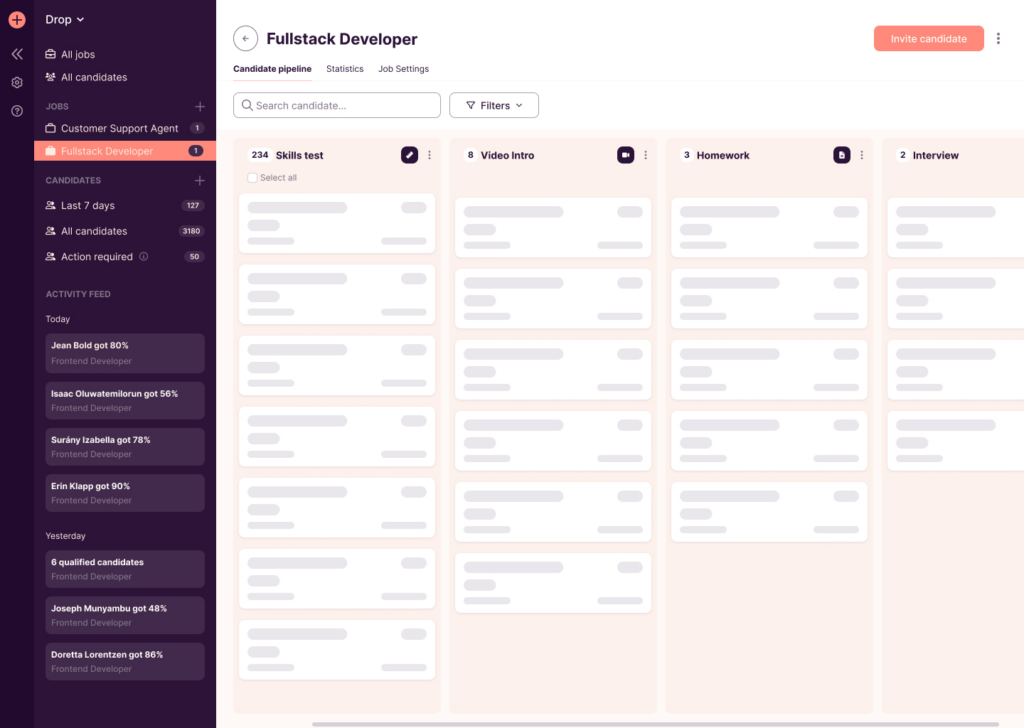
TalentReef
Best for: Managing an hourly workforce
Summary: TalentReef is an online hiring and talent management platform designed specifically for managing hourly employees. It streamlines the entire process, from hiring to onboarding and performance reviews, all in one platform. It’s best suited for businesses that rely heavily on hourly workers, such as restaurants, retail stores, and hospitality companies.
Key Features: ATS, onboarding tools, performance reviews
Pricing: From $55/month
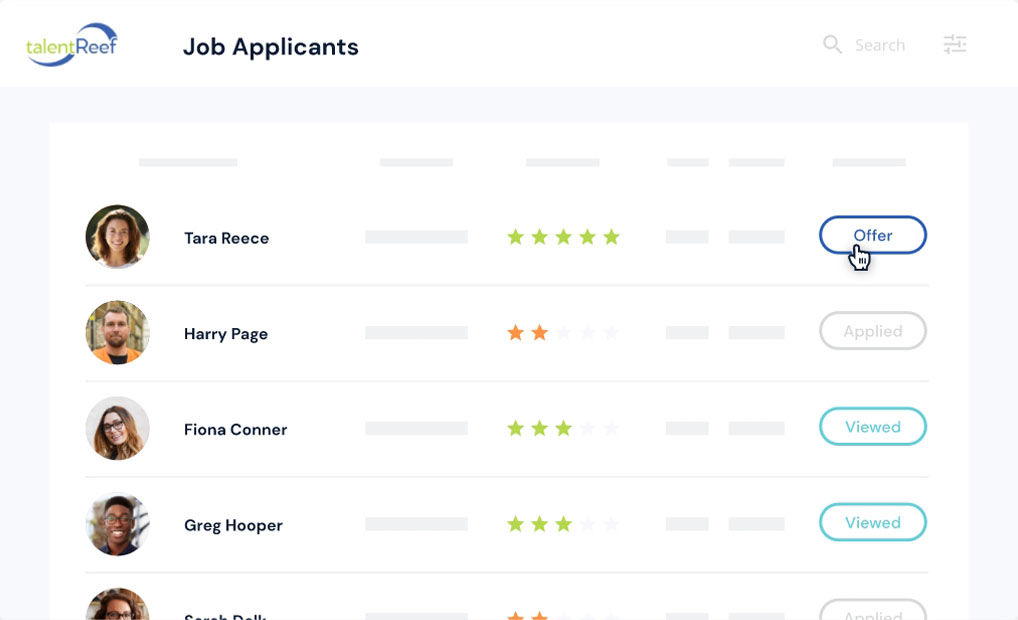
Deel
Best for: Remote and global hiring
Summary: Deel specializes in global hiring, focusing on international contracts, payments, and compliance for remote teams. It simplifies the complexities of international hiring and ensures legal compliance, making it ideal for businesses with distributed teams or remote workers.
Key Features: International payroll & compliance management
Pricing: From $49/month
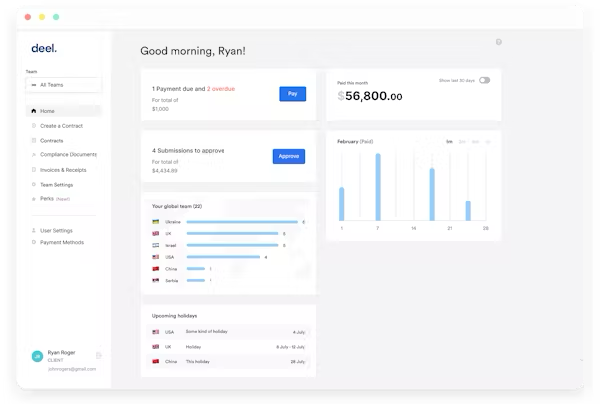
Manatal
Best for: Businesses interested in heavily AI-powered tools
Summary: Manatal is a comprehensive recruitment platform that covers the entire recruitment cycle, from initial candidate sourcing to onboarding. It offers end-to-end recruitment, including sourcing, interviewing, and applicant tracking.
Key Features: ATS, collaboration features for teams, resume parsing, candidate matching
Pricing: From $15/month per user

Zoho Recruit
Best for: Measurement and tracking insights
Summary: Zoho Recruit helps businesses streamline their hiring processes. It offers tools for sourcing candidates, managing resumes, scheduling interviews, and tracking applicant progress. Zoho Recruit is suitable for businesses of all sizes looking to improve their recruitment efficiency and make data-driven hiring decisions.
Key Features: Job posting management, candidate scoring, interview scheduling, third-party integrations
Pricing: From $25/month per user

Hire quality candidates with Toggl Hire
High-volume hiring doesn’t have to be time-consuming, stressful, or expensive. By leveraging the power of automation and the right recruitment tools, you can ensure that you get the best candidates in a fraction of the time.
Get started with a free Toggl Hire account today.
Julia is a freelance writer and fierce remote work advocate. While traveling full-time, she writes about the intersection of technology and productivity, the future of work, and more. Outside work, you can find her hiking, dancing, or reading in a coffee shop.






